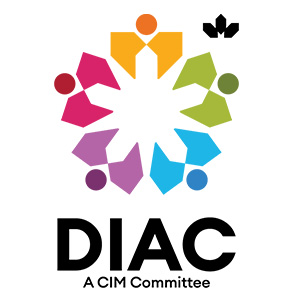Purpose: This document is intended to provide a guideline for the implementation of new, or revisions to existing, diversity and inclusion policies guidelines to CIM members and branches in order to further promote and integrate diversity amongst the mining sector.
Introduction
In 2013, CIM established the Diversity & Inclusion Advisory Committee (DIAC) to look at ways to further promote and integrate diversities within CIM and the industry at large.
Diversity in the labour force describes the extent to which workers can be distinguished by visible and invisible differences. Inclusion is achieved in supportive and respectful work environments that are reflective of diverse values where all employees can access opportunities and contribute in an equitable manner.
Diversities that are commonly identified in relation in a work environment are:
- Gender
- Indigenous People
- Race / Visible Minorities
- Age
- Neurodiversity
- Disabilities
- Sexual Orientation
- Religion
- Ethnicity
- Country of Origin
- Culture
Why Diversity and Inclusion?
They are human rights for all
“The Canadian Human Rights Act is a broad-reaching piece of legislation that prohibits discrimination on the basis of gender, race, ethnicity and other grounds. Also, Canada's Employment Equity Act and the Federal Contractors Program require employers to take active measures to improve the employment opportunities for specific groups of people in our country.”
“The Employment Equity Act is a federal law that requires federally regulated organizations and businesses to provide equal employment opportunities to four designated groups:
- women
- Aboriginal peoples (Indian, Inuit, or Métis)
- people with disabilities
- members of visible minorities”
(Source: https://www.canada.ca/en/canadian-heritage/services/rights-workplace.html)
Diversity disclosure is a legal requirement
“Effective January 1, 2020, corporations governed by the Canada Business Corporations Act (CBCA) with publicly traded securities will be required to provide shareholders with information on the corporation’s policies and practices related to diversity on the board of directors and within senior management, including the number and percentage of members of the board and of senior management who are women, Aboriginal persons, members of visible minorities and persons with disabilities. These requirements go beyond the disclosure required under Canadian securities rules and apply to all “distributing corporations” governed by the CBCA, including venture issuers (which are not subject to the securities law diversity disclosure requirements).”
It is good business
A well- integrated diverse workforce brings value, itby unlocksing internal capacity of organizations and increasinges creativity and performance of their workforce.
A McKinsey study on the impact of integrated diversity states:
“Our latest analysis reaffirms the strong business case for both gender diversity and ethnic and cultural diversity in corporate leadership—and shows that this business case continues to strengthen. The most diverse companies are now more likely than ever to outperform less diverse peers on profitability.”
It increases the talent pool
Tight labour markets can benefit from enlarged talent pools with inclusive and innovative work environment attracting a more diverse workforce.
“Attracting talent from various demographic groups can help strengthen the mining labour market; however, the mining industry struggles to engage workers from different demographic groups. Geographical challenges can compound these recruitment issues since certain demographic groups such as youth, visible minorities, and immigrants typically live in larger metropolitan areas while mines are often located in remote areas.
In mining and quarrying, the ratio of unemployed to job vacancy is almost equal (1.4 unemployed people per job vacancy in 2018); job vacancies exceeded unemployed in the fourth quarter of 2018.”
(Source: https://mihr.ca/wp-content/uploads/2020/03/MIHR_National_Report_web2.pdf)
Implementation Guide
Step 1: Executive Leadership Commitment
Leadership from executive level management is required at the initial stage of implementation to provide guidance, support, and to reinforce the message across the organization. They can:
- Create a diversity and inclusion policy and assessment matrix.
- Assess the executive level diversity, including at the executive board level where applicable.
- Create a committee for the implementation and creation of the diversity and inclusion strategy.
Step 2: Organizational Values
Organizational values need to change to reflect the values of a diverse workforce. Inclusions of diversities will fail unless their values are intrinsically aligned with the values of the organization. Diversity and inclusion should be part of organizational goals that are tracked and managed as part of a performance matrix. Actions can include:
- Completing an assessment and gap analysis of diversity and inclusion within the organization. This can be either an internal undertaking or completed by a third party.
- Create a plan and roadmap for the implementation of a diversity and inclusion program.
Step 3: Education and Training
Develop an educational plan for all levels of the organization, implement, and assess implementation on a continual basis. Identifying key performance indicators and predetermined evaluation milestones to assess implementation will be a key factor in the success of the program. Understanding the benefits of a diverse workforce, and the differences in needs and values of the diverse population will be key elements of acceptance and full engagement of the diverse groups.
It is recommended that organization leaders communicate and seek feedback from all employees regularly by:
- Establishing ongoing diversity and inclusion training and events involving all levels of the organization;
- Seeking feedback on effectiveness of training and make adjustments.
Step 4: Update Your Organization’s Recruitment Process
To attract diverse talent to your organization, it is a prerequisite to understand the capabilities of diverse groups and adjust the recruitment process and job descriptions to be mutually beneficial, to potential candidates and the organization. Organizations endeavoring to create or update their recruitment process may take the following actions.
- Contact organizations representing diverse groups and use their expertise to expand existing hiring practices and the organization’s hiring network. Provide co-op and internship opportunities to students from diverse backgrounds. Leverage opportunities to recruit an employee from local communities where you operate or where you are doing work.
Step 5: Employee Retention Programs
Create an equitable environment that will unlock the full potential of diverse groups. Some ideas include:
- Change employee assessment programs and adjust promotion practices accordingly.
- Create social activities inclusive of all diverse groups.
- Provide mentorship and coaching programs for individuals requiring an adjustment period, and support them at regular intervals.
- Actively encourage and engage employees from diverse groups to join trade organizations and internal initiatives.
- Adjust to the company’s work environment, both physical and procedural, to suit a more inclusive culture.
- Provide alternative working arrangements including flexible hours, place of work, and transportation.
Appendix
Selected Examples: What else can you do now?
Apply the ideas below at home, awork, in your community, in your volunteer activities, and in your social circles.
In the working environment (inclusive management / volunteer committees)
- Pay attention to how events are selected - (i.e., celebrations and holidays).
- Pay attention to meeting times, and methodologies - do they suit a diverse group? (Single parents, tech savvy folks, people with disabilities, etc.)
- Review who gets opportunities to sit on the executive board and how positions and promotions are awarded.
- Reflect on how everyone is given room to contribute and share ideas.
- Look for opportunities to lend your unique voice to problem- solving.
- Can everyone exercise basic human rights within your present set up (i.e., Ie washrooms, PPE, etc.)?
- Ask how meetings are being conducted. Is there an opportunity to ensure quiet voices are heard?
- Pay attention to body language. Are people comfortable?
- Conduct pulse check surveys with very specific questions around inclusion.
- Review standard operating procedures, policies, job postings, and other documentation to ensure gender-specific language is not used.
- Observe people working to identify potential barriers.
- Track who is participating on committees and ensure diversity on said committees.
During the Recruitment Process
- Use inclusive language in job postings.
- Pay attention to how decisions are made (i.e., shortlisting potential candidates).
- Create diverse recruitment teams and interviewers for the hiring process.
- Consider engaging an expert to review job postings to prevent unintentionally alienating applicants from diverse groups.
- Consider changing your interview “style” to ensure the interview process is not a barrier to a more inclusive workplace.
- Ask applicants if they need accommodation for testing and ensure they have ample time and resources to be successful if required.
Self-Education
- Educate yourself - look for courses you can take on LinkedIn Learning, Ted Ttalks, or other online learning platforms.
- Reflect on where your knowledge of certain demographics of people comes from (i.e., television, music, etc.)
- Read books on how to be more inclusive.
Working with suppliers, consultants, and contractors
- Ask equipment suppliers if equipment has been designed for different body types and sizes. Continue to ask the questions and push for more inclusive equipment.
Message from the DIAC Committee
How can you contribute to this guideline?
This document is intended to spark conversations. Your input is appreciated to continue to provide the mining industry with guidelines for implementation.
 - dev.png)


